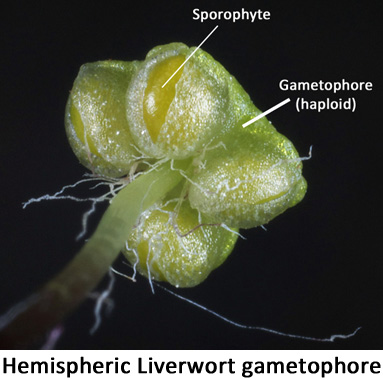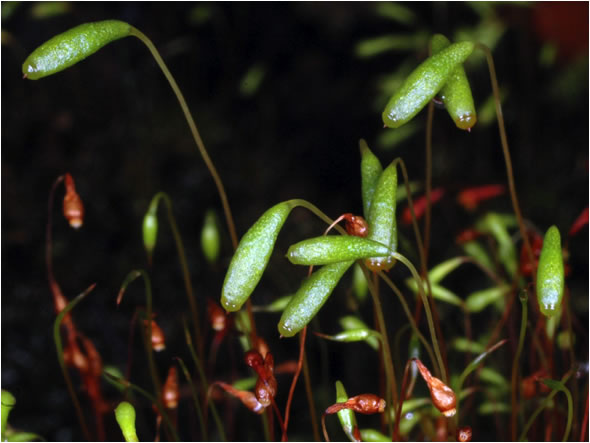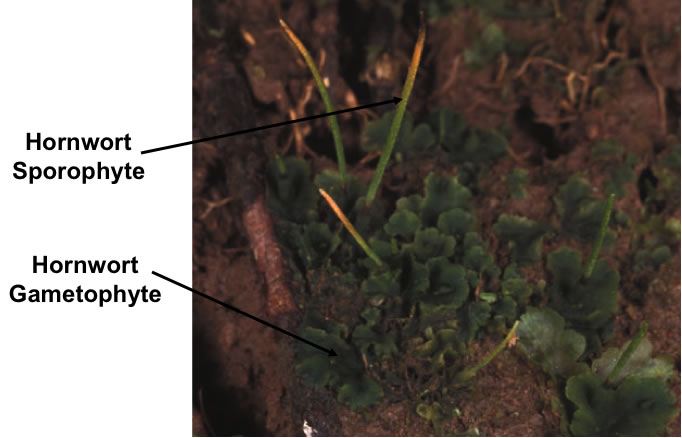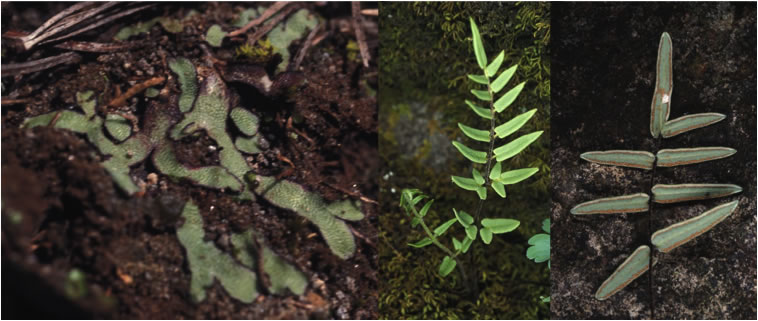Alternation of Generations
All plants alternate between a haploid gametophyte generation that produces gametes (sperm and/or egg) and a diploid sporophyte generation that produces spores. Because gametophytes are already haploid, the nuclei of the resulting sperm and egg cells they produce are genetically identical to the gametophyte nuclei. After fusion of a sperm cell and egg cell into a diploid zygote, recombination can occur between the homologous chromosomes donated from the two parent gametophytes. When diploid sporophyte cells undergo meiosis to produce haploid spores that will grow into the next generation of haploid gametophytes, the resulting haploid nuclei of the new gametophytes will have a shuffled combination of genes from the previous generation's parent gametophytes thanks to that recombination.
In the algal relatives of land plants, the diploid life stage lasts only long enough for recombination to occur in the zygote before spores are produced. In nonvascular plants, the diploid zygote developes into a small, short-lived sporophyte. In vascular plants, the gametophyte is much reduced and the sporophyte is the dominant, long-lived life stage. In seed plants, the gametophytes are so reduced that they are no longer free-living. The spores are never released outside the sporophyte and develop into few-celled gametophytes within sporophyte pollen and ovule tissue.
Taxa
Haploid Gametophyte
Diploid Sporophyte
Green Algae relatives of embryophytes
Entire life of the alga is haploid except for zygote cells.
Zygote is the only diploid cell; immediately completes meiosis after recombination
to produce haploid spores
Liverworts
Long-lived; all of the photosynthetic tissue of the liverwort is haploid, including
the stalked, umbrella-like gametophores
Multicellular, but short-lived, usually small, inconspicuous, and produced underneath
female gametophores and dependent upon the female parent gametophyte for nutrition
Mosses
Long-lived; the photosynthetic part of a moss (i.e. the main plant body)
Usually long-stalked with a sporangium at the summit (looks like a golf club), short-lived
and dependent upon female parent gametophyte for nutrition
Hornworts
Long-lived; the photosynthetic plant body of a hornwort
The 'horn' of a hornwort; often green and appearing photosynthetic, but still short-lived
and partially dependent on female gametophyte
Clubmosses
Very tiny, inconspicuous, dies when the large sporophyte quickly outgrows it; some
are photosynthetic, some are mycotrophic
Long-lived and large; the visible 'clubmoss' plant
Spikemosses
Either male (smaller, microscopic) or female (larger, but still requiring magnification);
developing primarily within the spore wall
Long-lived and large; the visible 'spikemoss' plant
Quillworts
Either male (smaller, microscopic) or female (larger, but still requiring magnification);
developing within the spore wall
Long-lived and large; the visible 'quillwort' plant
Ferns
Variable, ranging from microscopic to a few centimeters; some mycotrophic, but mostly
photosynthetic and thalloid; aquatic fern gametophytes unisexual, microscopic, and
similar to Spikemosses and Quillworts
Long-lived and large; the 'fern' life stage of a fern.
Gymnosperms
Unisexual and only a few cells embedded in diploid sporophyte tissue; male spores
generate sperm nuclei within pollen; female gametophyte generates an egg cell within
ovule; never free-living
The entire plant except a few cells contained within pollen and ovules.
Angiosperms (flowering plants)
Unisexual and only a few cells embedded in diploid sporophyte tissue; male spores
generate sperm nuclei within pollen; female gametophyte generates an egg cell within
ovule; never free-living
The entire plant except a few cells contained within pollen and ovules.



Liverwort and moss gametophytes Moss sporophytes


Purple Cliffbrake gametophytes Purple Cliffbrake sporophyte and sori










